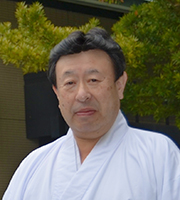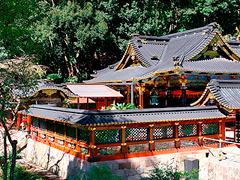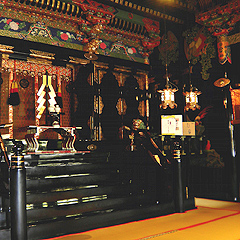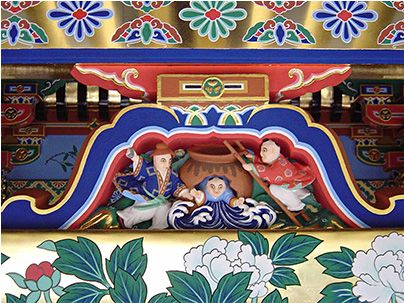About Kunozan Toshogu
Welcome to Kunozan Toshogu Shrine
We are delighted to welcome visitors from all over the world to the Kunozan Toshogu Shrine. The shrine has a history of over 400 years, and enshrines Lord Tokugawa Ieyasu, who founded the Tokugawa Shogunate in 1603 that brought peace to Japan for 265 years. The beautifully decorated shrine buildings were designated as a National Treasure in 2010.
Enshrined kami (deities) / origin

Enshrined kami (deities)
The Honden where the deities are enshrined contains three spaces – in the center is enshrined Tokugawa Ieyasu, while enshrined on either side are Oda Nobunaga and Toyotomi Hideyoshi, two famous military commanders.
History of the Shrine
Lord Tokugawa Ieyasu (1542-1616) endured many hardships in his youth before becoming the first Tokugawa shogun in 1603. He retired as Shogun in 1605, and spent the remainder of his days in Sumpu, the current Shizuoka City. He passed away on the 17th of April in 1616 at the age of 75.
Before his death Ieyasu had instructed his retainers to bury his remains at Kunozan. Ieyasu’s successor, the second Shogun, Tokugawa Hidetada carried out Ieyasu’s instructions and ordered a shrine to be built to enshrine Tokugawa Ieyasu.
A master carpenter named Nakai Masakiyo was chosen to build the shrine. Construction started in May of the year of Ieyasu’s death and the shrine was completed within a year and seven months. The shrine was built using the finest craftsmen of the time and became a model for other Toshogu shrines all over Japan, including the Nikko Toshogu Shrine. Other examples of Nakai Masakiyo’s workmanship include such important historical structures as Nagoya Castle (a nationally designated important historic site), and in Kyoto Ninnaji Temple (a National Treasure and World Heritage Site) and Nijo Castle (a National Treasure and World Heritage Site). The Kunozan Toshogu shrine is considered a masterpiece of Nakai Masakiyo’s later years and was designated as a National Treasure in 2010.
Message from the Chief Priest
 Welcome to the official site of Kunozan Toshogu.
Welcome to the official site of Kunozan Toshogu.
My name is Himeoka Yasuhiko and I am the chief priest. Kunozan Toshogu enshrines Tokugawa Ieyasu, who was deified with the deity name Tosho-okami, hence Toshogu (-gu meaning shrine). There are many Toshogu shrines around Japan, including Nikko Toshogu. Kunozan Toshogu in Shizuoka city is the first of these shrines, since the history of Toshogu and the enshrinement of Tokugawa Ieyasu began here in Shizuoka.
Tokugawa Ieyasu was a great historical figure who lived through a turbulent period of Japan’s history. He devoted his life to bringing peace to Japan, by unifying a country that had fragmented into a large number of warring states controlled by warlords and generals. Tokugawa Ieyasu created a unified state, bringing an end to a long period of civil war. The basis of Tokugawa Ieyasu’s nation building policy was to value the life of the individual, to develop and strengthen education throughout the country and to pursue peaceful relations with foreign powers through diplomacy and trade.
Shortly before his death, Ieyasu gave instructions that he be buried at Kunozan. As instructed, his remains were buried at Kunozan after his death. His successor, shogun Tokugawa Hidetada, had a shrine built to enshrine him. The magnificent shrine was made by one of the master craftsmen of the Edo period, Nakai Masakiyo. Nearly 400 years after it was built, the main shrine, the Ishi-no-ma, which separates the main shrine from the worship hall, and the worship hall were designated as a national treasure on 24th December 2010.

There are three main reasons why Kunozan Toshogu is a national treasure:
- The foundations, nearly 400 years old, remain almost intact;
- Master craftsman Nakai Masakiyo created many buildings that are designated as national treasures, of which Kunozan Toshogu is the last;
- The Kunozan Toshogu is the original Gongen-Zukuri style of shrine architecture, which is differentiated by the Ishi-no-ma between the main shrine and the worship hall.
Please enjoy your visit to the shrine.
Gongen-zukuri and the Ishi-no-ma

The Ishi-no-ma is the sunken space between the main hall and the worship hall. Although the name literally means ‘stone room’, the floor is not actually made of stone. The name is a reference to the corridor with a stone floor which normally connected two shrine buildings, which the Ishi-no-ma replaces. The Ishi-no-ma style that started at Kunozan Toshogu became a new architectural standard for shrines and temples. This style of shrine building with an Ishi-no-ma is called ‘Gongen-Zukuri’, since in the Edo period Tokugawa Ieyasu was also known by the title Gongen-sama. The Ishi-no-ma is an important space connecting the world of the gods and the world of mortals, where many religious rites are performed.

The shrine has many beautiful sculptures and paintings that visitors can admire, but it also conveys an important message of peace from Tokugawa Ieyasu to us living in the modern era, which we hope that you may absorb during your visit to the shrine.
Valuable cultural artifacts tracing the footsteps of Tokugawa Ieyasu’s education and diplomacy of peace are on display in the Museum.
Rituals and events
Approximately 60 rituals and events are held at Kunozan Toshogu throughout the year, of which the Grand Spring Ritual (February 17), the Annual Grand Ritual (April 17), and the Grand Autumn Ritual (October 17) are the most important.
Goreisai (Annual Major Ritual)

This ritual is held on April 17th, the day on which Tokugawa Ieyasu passed away. A direct descendant of Ieyasu’s family attends this ritual. During this very solemn ritual, and only at this festival, over fifty different types of delicacies from the mountains, the fields and the seas from all across Japan are presented to the deities. This tradition dates back to the time when the Toshogu was established and continued until 1872. The tradition was revived at the 350th anniversary of Kunozan Toshogu in 1965 and has been an annual event ever since.

The offerings from three places for the deity
These are special offerings presented only at the annual Ritual, the Goreisai. These offerings were presented from the time Toshogu was established until 1872 when the event was discontinued. The tradition was revived at the 350th anniversary of Toshogu and has been an annual event since then. About 50 different foods from the mountains and the sea are placed on special metal dishes. These foods are special delicacies from across Japan.
The Grand Spring Ritual

This ritual is held over two days on February 16 and 17th
February 16th Ongusoku Ritual (Armour Ritual)
In the Edo period (1603-1867) the Shogun and samurai families would display suits of armour on January 11th during the New Year celebrations, and make offerings of rice cakes before them. At Kunozan, suits of armour were displayed from New Year's Day until January 16th. This ritual continued until the end of the 19th century and was revived in 1965. Three suits of armour of successive Shoguns are displayed in the Ishi-no-ma. Good luck charms and rice cakes are placed in front of each suit of armour. The rice cakes are called Gusoku Mochi (Armour Rice Cakes). The ritual with the armour of the three successive Shoguns is carried out with the utmost solemnity and prayers for national prosperity and world peace are offered.
February 17th Grnad Spring Ritual
In the Edo period the Grand Spring Ritual was held on the 17th of January in accordance with the lunar calendar. This was the date when people paid their respects to the gods for the first time that year. This continued until the Meiji Period (1868-1912). The date was changed from January 17 to February 17 when the Gregorian calendar was adopted in 1910. Festivals with prayers for world peace and a bountiful harvest are held at shrines throughout the country on this date.
The Grand Autumn Ritual


The Grand Autumn Ritual was held on September 17th according to the lunar calendar in the Edo period. The date was changed to the 17th of October when the Gregorian calendar was introduced, and the Grand Ritual became the Grand Autumn Ritual. Archery is included in this festival because Tokugawa Ieyasu was a skilled archer and it is said that he was the best archer of his day in the Tokai area of central Japan. Buddist priests come to Toshogu from Rinzai Temple where Ieyasu spent time when he was a child. They recite a sutra in front of the shrine where Ieyasu sleeps eternally.
Main events
| The 1st of every month | Tsukihajime sai (Beginning of the Month Ritual) | ||
|---|---|---|---|
| The 17th of every month | Tsukinami sai (Monthly Ritual) | ||
| The 26th of every month | Tsukinami tanshin sai (Monthly Birth Date Ritual) | ||
| January 1st | Saitan sai (New Year's Prayers for good fortune) | ||
| January 3rd | Genshi sai (Celebration of the Founding of the Imperial House) | ||
| January 11th | Okagami biraki hokoku sai (Breaking of the Rice Cakes Ritual) |
 |
|
| February 3rd | Kogi setsubun sai (The end of winter Ritual) |
 |
|
| June 30th | Oharae shiki (Semi-annual great purification ritual held in summer) Nagoshi no harai |  |
|
| December 13th | Osusu harai (The cleaning of the statues and of the inside of the shrine) | ||
| December 31st | Oharae shiki (Semi annual great purification ritual held at the end of the year) Joya sai (End of year purification rite) | ||
Admission charges

Individuals
| Shrine | Museum | Shrine and museum | |
|---|---|---|---|
| Adults | 500 yen | 400 yen | 800 yen |
| Children | 200 yen | 150 yen | 300 yen |
Adults includes high school students
Groups
| Shrine | Museum | Shrine and museum | ||
|---|---|---|---|---|
| Adults | 25 people or more | 400 yen | 350 yen | 700 yen |
| 100 people or more | 380 yen | 310 yen | 650 yen | |
| High school students | 25 people or more | 300 yen | 300 yen | 550 yen |
| 100 people or more | 250 yen | 280 yen | 500 yen | |
| Elementary and junior high school students | 25 people or more | 150 yen | 120 yen | 250 yen |
| 100 people or more | 120 yen | 110 yen | 200 yen | |
Opening hours: Open everyday of the year
| AM9:00-PM17:00 |
|---|
Last entry 10 minutes before closing time
Kunozan Toshogu Shrine Office
Negoya 390
Suruga Ward
Shizuoka City
Shizuoka Prefecture
Japan 422-8011

